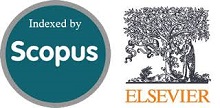Marshall Performance and Volumetric Properties of Styrene-Butadiene-Styrene Modified Asphalt Mixtures
DOI:
https://doi.org/10.28991/cej-2021-03091709Keywords:
Optimum Asphalt Content (OAC), Styrene-Butadiene-Styrene (SBS), Marshall Test, Volumetric Properties.Abstract
The durability of asphalt pavement is associated with the properties and performance of the binder. This work-study intended to understand the impact of blending Styrene-Butadiene-Styrene (SBS) to conventional asphalt concrete mixtures and calculating the Optimum Asphalt Content (OAC) for conventional mixture also; compare the performance between SBS modified with the conventional mixture. Two different kinds of asphalt penetration grades, A.C. (40-50) and A.C. (60-70), were improved with 2.5 and 3.5% SBS polymer, respectively. Marshall properties were determined in this work. Optimum Asphalt Content (OAC) was 4.93 and 5.1% by weight of mixture for A.C. (40-50) and (60-70), respectively. Marshall properties results show an increasement in the stability value by 8.65 and 20.19% for A.C. (40-50) with 2.5 and 3.5% of SBS, respectively. And an increasement by 9.32 and 20.61% for AC (60-70) with 2.5 and 3.5% of SBS respectively. Furthermore, the results indicate a decrease in Marshall flow by 14.7 and 26.47% for A.C. (40-50) with 2.5 and 3.5% SBS respectively and a decrease by 10.46 and 21.21% for A.C. (60-70) with 2.5 and 3.5% SBS respectively. Other Marshall properties were also calculated. Moreover, Blending SBS polymers to conventional asphalt mixtures produces a better performance to asphalt binder and better Marshall properties, which provides a great solution to Iraqi road problems affected by temperature and high traffic load, including less maintenance.
Doi: 10.28991/cej-2021-03091709
Full Text: PDF
References
[2] Munera, J.C., and E.A. Ossa. "Polymer Modified Bitumen: Optimization and Selection.” Materials & Design (1980-2015) 62 (October 2014): 91–97. doi:10.1016/j.matdes.2014.05.009.
[3] Wu, Shao-peng, Ling Pang, Lian-tong Mo, Yong-chun Chen, and Guo-jun Zhu. "Influence of Aging on the Evolution of Structure, Morphology and Rheology of Base and SBS Modified Bitumen.” Construction and Building Materials 23, no. 2 (February 2009): 1005–1010. doi:10.1016/j.conbuildmat.2008.05.004.
[4] Sengoz, Burak, and Giray Isikyakar. "Analysis of Styrene-Butadiene-Styrene Polymer Modified Bitumen Using Fluorescent Microscopy and Conventional Test Methods.” Journal of Hazardous Materials 150, no. 2 (January 31, 2008): 424–432. doi:10.1016/j.jhazmat.2007.04.122.
[5] Lewandowski, L. H. "Polymer Modification of Paving Asphalt Binders.” Rubber Chemistry and Technology 67, no. 3 (July 1, 1994): 447–480. doi:10.5254/1.3538685.
[6] Hamdou, Hamid Mahmoud, Mohammed Qadir Ismael, and Mohammed Assi Abed. "Effect of Polymers on Permanent Deformation of Flexible Pavement." Journal of Engineering 20, no. 12 (2014): 150.
[7] Airey, Gordon Dan. "Rheological characteristics of polymer Modified and Aged Bitumens" PhD diss., University of Nottingham, UK, (1997).
[8] Liu, Shutang, Weidong Cao, Jianguo Fang, and Shujie Shang. "Variance Analysis and Performance Evaluation of Different Crumb Rubber Modified (CRM) Asphalt.” Construction and Building Materials 23, no. 7 (July 2009): 2701–2708. doi:10.1016/j.conbuildmat.2008.12.009.
[9] Isacsson, U., and Huayang Zeng. "Relationships between Bitumen Chemistry and Low Temperature Behaviour of Asphalt.” Construction and Building Materials 11, no. 2 (March 1997): 83–91. doi:10.1016/s0950-0618(97)00008-1.
[10] Stuart, Kevin D. "Moisture damage in asphalt mixtures-a state-of-the-art report." Turner-Fair bank highway Research Center (1990).
[11] Pasandín, Ana R., Ignacio Pérez, Antonio Ramírez, and Miguel M. Cano. "Moisture Damage Resistance of Hot-Mix Asphalt Made with Paper Industry Wastes as Filler.” Journal of Cleaner Production 112 (January 2016): 853–862. doi:10.1016/j.jclepro.2015.06.016.
[12] Obaid, Hayder Abbas. "The effect of styrene-butadiene-styrene on moisture damage resistance of asphalt mixtures." Journal of University of Babylon 23, no. 2 (2015): 263-270.
[13] Chen, Jian-Shiuh, Min-Chih Liao, and Ming-Shen Shiah. "Asphalt Modified by Styrene-Butadiene-Styrene Triblock Copolymer: Morphology and Model.” Journal of Materials in Civil Engineering 14, no. 3 (June 2002): 224–229. doi:10.1061/(asce)0899-1561(2002)14:3(224).
[14] Mirzaiyan, Danial, Mahmoud Ameri, Amir Amini, Mohammadreza Sabouri, and Amirhossein Norouzi. "Evaluation of the Performance and Temperature Susceptibility of Gilsonite- and SBS-Modified Asphalt Binders.” Construction and Building Materials 207 (May 2019): 679–692. doi:10.1016/j.conbuildmat.2019.02.145.
[15] Mansour, Ahmed, N Ghaly, Akram Eldidamony, Maher Nessim, and Manal Mohamed. "Improving the Aging Effect of Bitumen and SBS Modified Bitumen by Using Newly Prepared Antioxidants.” Egyptian Journal of Chemistry 63, no. 6 (November 14, 2019): 2213–2233. doi:10.21608/ejchem.2019.18500.2151.
[16] Sengoz, Burak, Ali Topal, and Giray Isikyakar. "Morphology and Image Analysis of Polymer Modified Bitumens.” Construction and Building Materials 23, no. 5 (May 2009): 1986–1992. doi:10.1016/j.conbuildmat.2008.08.020.
[17] Doha Niethal SAAD, Eman Ismael AHMED "Rheology of Iraqi Asphalt Modified with SBS, Polyphosphoric Acid and Sulfur" International Conference on Technology, Engineering and Science (IConTES), October 26-29, 2018 Antalya, Turkey.
[18] Leng, Zhen, Anand Sreeram, Rabindra Kumar Padhan, and Zhifei Tan. "Value-Added Application of Waste PET Based Additives in Bituminous Mixtures Containing High Percentage of Reclaimed Asphalt Pavement (RAP).” Journal of Cleaner Production 196 (September 2018): 615–625. doi:10.1016/j.jclepro.2018.06.119.
[19] Tunnicliff, D.G; and Root, R. E. "Use of Anti stripping Additives in Asphalt Concrete Mixture; Field Evaluation”, Final Report, Report NCHRRP 373, USA, p 58. Available online: http://onlinepubs.trb.org/Onlinepubs/nchrp/nchrp_rpt_373.pdf (accessed on January 2021).
[20] Ahmadinia, Esmaeil, Majid Zargar, Mohamed Rehan Karim, Mahrez Abdelaziz, and Ebrahim Ahmadinia. "Performance Evaluation of Utilization of Waste Polyethylene Terephthalate (PET) in Stone Mastic Asphalt.” Construction and Building Materials 36 (November 2012): 984–989. doi:10.1016/j.conbuildmat.2012.06.015.
[21] Luo, Min. "Study of Asphalt Performance Impact with Ultraviolet Aging.” IOP Conference Series: Materials Science and Engineering 231 (September 2017): 012107. doi:10.1088/1757-899x/231/1/012107.
[22] Veranko, V. A., A. V. Ladyshau, and R. K. Hatalski. "Investigation of Fatigue Life for Asphalt Concrete Modified by Polymer Additives of Various Types.” Science & Technique 17, no. 6 (December 13, 2018): 451–457. doi:10.21122/2227-1031-2018-17-6-451-457.
[23] Shah, Peerzada Mosir, and Mohammad Shafi Mir. "Performance of OMMT/SBS on the Rheological Properties of Asphalt Binder.” Korea-Australia Rheology Journal 32, no. 4 (November 2020): 235–242. doi:10.1007/s13367-020-0022-5.
[24] SCRB, General Specification for Roads and Bridges. Section R/9, Hot-Mix Asphalt Concrete Pavement, Revised Edition. State Corporation of Roads and Bridges. Baghdad: Ministry of Housing and Construction, Republic of Iraq, (2003).
[25] ASTM. "Road and Paving Materials Vehicle Pavement Systems." Annual Book of ASTM Standard (2015): Vol. 04.03. American Society for Testing and Materials.
[26] Al-Suhaibani, Abdulrahman Saleh. "Effect of aggregate properties on asphalt concrete mixes." Engineering Sciences 7, no. 1 (1995): 93-110.
Downloads
Published
Issue
Section
License
- authors retain all copyrights - authors will not be forced to sign any copyright transfer agreements
- permission of re-useThis work (including HTML and PDF Files) is licensed under a Creative Commons Attribution 4.0 International License.







